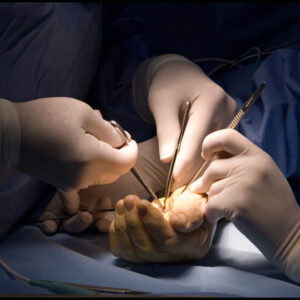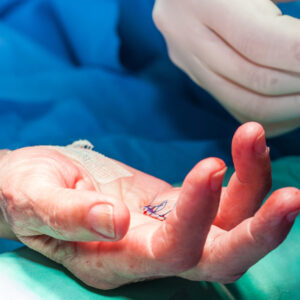email: [email protected]
call: 07494 250277

Dupuytren’s Contracture
Dupuytren’s Contracture
Dupuytren’s Contracture or Palmer Fibromatosis is a condition of uncertain cause. It is marked by a thickening and tightness of the Palmer fascia causing one or more of the fingers (and rarely the Thumb) to bend into the palm.
The condition tends to run in families and usually develops after the age of 40. It is more common in men.
Symptoms of Dupuytren’s Contracture
Initially the condition is noted by a painless lump in the palm, usually at the base of the ring or little finger; although other digits are less commonly affected. Gradually this nodule develops into a cord, which extends into the finger pulling to bend the finger into the palm preventing it from being straightened.
Patients, at this stage, may have difficulty in gripping. As the contracture worsens the bent finger(s) get in the way and annoy good hand use.
Treatment for Dupuytren’s Contracture
Treatment is indicated when you can no longer place the hand flat on a table. The mainstay of treatment has, so far, involved surgical removal of the affected palmer fascia (limited Fasciectomy).
This operation can be performed either under a general anaesthetic or by paralysing your arm with a local anaesthetic injection in the armpit.
Complications of Surgery
- Infection
- Bleeding and Haematoma.
- Injury to one or both of the digital nerves or arteries at the time of surgery leading to reduced sensation in the finger.
- Complex Regional Pain Syndrome (5%).
- Delayed wound healing.
Dupuytren’s contracture can recur after surgery especially in those with a strong family history, when the condition starts at a young age or when there is similar thickening of the fascia of the sole of the foot.
An operation of Dermofasciectomy, which involves replacing the overlying palmer skin, with a skin graft, may reduce the risk of recurrence.
Other treatments for Dupuytren’s Contracture have been used
These include Percutaneous fasciotomy in certain situations. More recently Collagenase injections have been available until. recently as an alternative. Early results from trials were quite promising. Unfortunately this treatment is now no longer available in the UK and can only be administered if you were to consent to be recruited. into a clinical trial, called the DISC Trial.
Expected recovery after fasciectomy
After surgery the hand and fingers will be numb still. Sensation will return once the local anaesthetic wears off (8 to 12 hours). Keep the hand elevated.
Prior to discharge the staff will review the wounds. A splint may be required to hold the finger straight. This is not always needed.
The dressings will be reduced or removed after 3 days to allow hand therapy.
An appointment will be arranged to remove sutures at 10 days at which point you should be able to wash your hand and apply a moisturising cream to help soften the scars. Expect the scar to be dry and scaly at this stage.
Scar tissue will be rather thick in the first few months after surgery but this will settle. The Hand Therapists will encourage and guide you in the use of the hand.
You may be advised to use your splint for up to 3 months, probably at night only.
You can usually drive a car after 4 weeks as long as you are comfortable and have regained good finger movements. Timing of your return to work is variable according to your occupation and you should discuss this.
Mr Fitton would be pleased to meet you to discuss your case and to give you more information and advice.
You may also wish to visit the British Society for Surgery of the Hand.




Surgery, either as a fasciectomy or demo-fasciectomy and skin graft, remains the mainstay of treatment.




